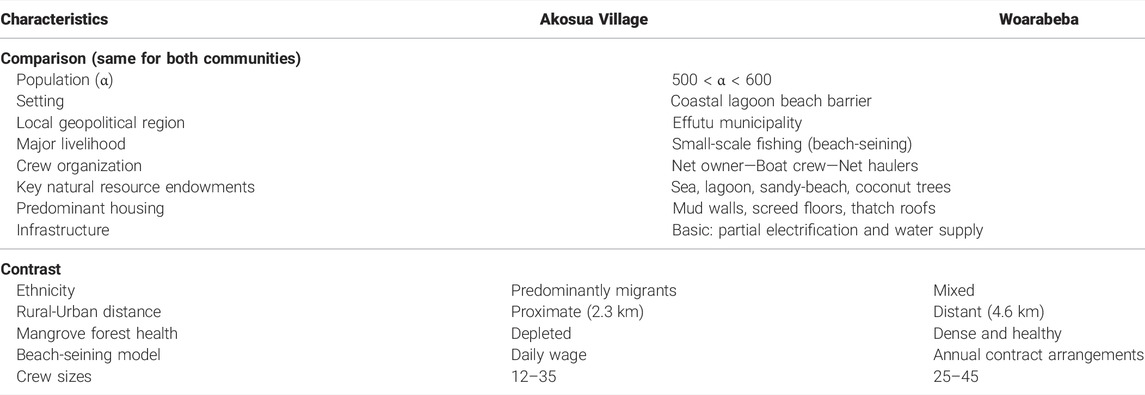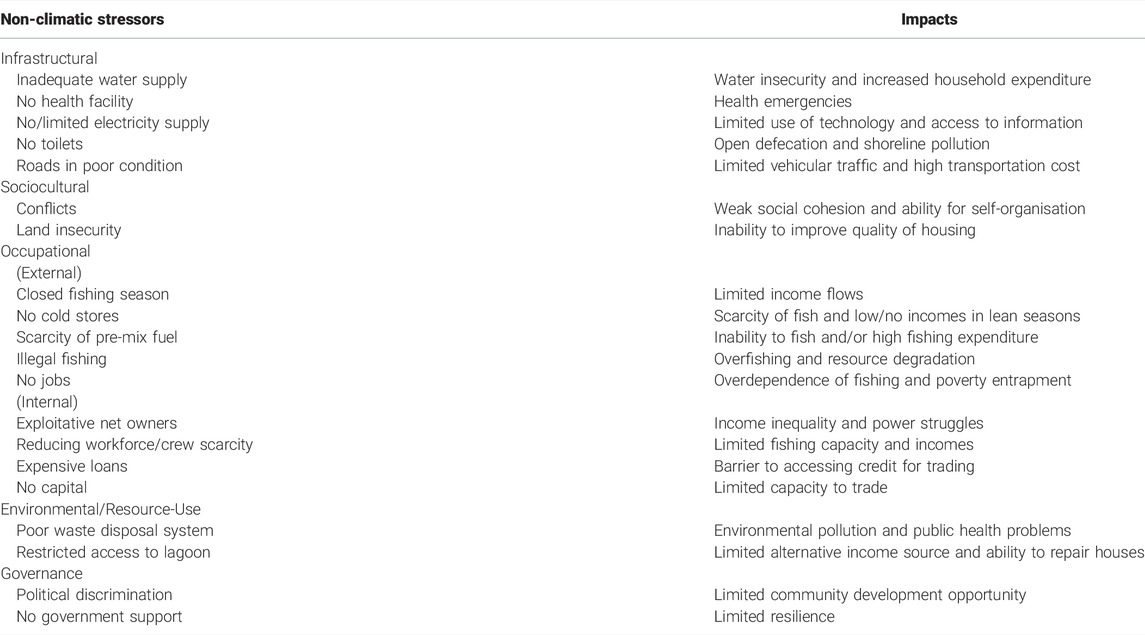- Environmental Sustainability Research Centre, University of Derby, Derby, United Kingdom
This study examines the relative importance and severity of climate change in the context of multiple socio-economic stressors in rural coastal fishing communities in Ghana. Although climate change poses significant threats to these communities, it is yet unclear where it fits in the range of stressors that shape the vulnerability of such communities. Without an understanding of how vulnerability is experienced by the fishing communities, it is difficult to appreciate what adaptation to climate change means to them and which adaptation options are realistic. Household surveys, interviews, gender and age-group disaggregated focus group discussions and participatory risk mapping were used to assess type, importance and severity of climatic and socio-economic stressors that impinge on the lives and livelihood of the fishing communities. Climatic stressors include erratic rainfall, increased storminess, flooding and high temperatures. Socio-economic stressors include infrastructural (e.g., water and energy insecurity), socio-cultural (e.g., conflicts and land insecurity), occupational (e.g., exploitation, power asymmetries, illegal fishing), and environmental (e.g., plastic waste pollution) factors. The participatory risk maps showed that climatic stressors generally rank higher than all others in importance due to their direct impact on fishing and fish processing activities. However, socio-economic stressors were more severely felt, especially in major fishing seasons. The study therefore highlights socio-economic stressors as realistic focus for adaptation priorities that can safeguard the lives, livelihood and wellbeing of rural coastal-small scale fishing communities.
Introduction
In the latest State of the World’s Fisheries and Aquaculture report, the Food and Agriculture Organisation (FAO), estimated that about 60 million people globally are engaged in the primary activity of capture fishing (FAO, 2018). If all those employed along the fish value chain are considered, it is estimated that the fishing industry is a source of livelihood for up to 820 million people worldwide (Béné, 2006; Sumaila et al., 2011; FAO, 2018). The global first-sale value of fish in 2016 was estimated at about $362 billion, 35% of which was generated through the fishing activities of small-scale marine fishers (FAO, 2018). It is estimated furthermore, that about 90% of the fish the world consumes is produced by small-scale marine fishers who are mostly located in remote rural coastal fishing-dependent communities in tropical developing and least developed countries in Asia and Africa (Westlund, 2007; Badjeck et al., 2010; FAO, 2015). In such communities, household incomes and the community economy are so dependent on fishing that the loss of or significant alteration to fishing livelihoods threatens their very existence (Jacob et al., 2001). Although small-scale fishing (SSF) is a significant contributor to a growing multi-billion fishing industry, the communities where the fishing activities take place are typically characterised by extreme poverty, deprivation and vulnerability to multiple socio-economic stressors (Carney, 1998; Tilley et al., 2018). Socio-economic stressors include lack of access to credit facilities, poor infrastructure, limited educational and employment opportunities and top-down governance structures. Climate change adds to and exacerbates the already existing socio-economic challenges faced by rural coastal fishing-dependent communities. Generally, coastal areas are considered to be some of the most vulnerable places to climate change risks. They are affected by changes to storm patterns and strength, sea-level rise (SLR), and flooding (Adger, 1999; Islam et al., 2014). In addition, rising sea surface temperatures, ocean acidification, and deoxygenation affect marine ecosystems, impacting the productivity and availability of already overexploited fish stocks (Cheung et al., 2010; Sumaila et al., 2011; Lam et al., 2012; Belhabib, Lam and Cheung, 2016). These impacts are expected to be strongest in tropical coastal regions, such as West Africa, where the majority of small-scale fishing communities are located (Bunce et al., 2010; Lam et al., 2012; FAO, 2018). However, there have been concerns that global and national focus on climate change mitigation can distract from the developmental challenges that SSF communities face. To define priorities and/or maintain an appropriate balance between the two issues requires an understanding of their relative importance through the lens of the lived experiences of those affected. Moreover, several authors (e.g., Bardsley and Wiseman, 2012; Gaillard, 2012; Nyantakyi-Frimpong and Bezner-Kerr, 2015) have argued that proposed climate change adaptation solutions could prove maladaptive when the climate change problem is not appropriately contextualised. Bardsley and Wiseman (2012) in particular, observe that a failure to consider climate change in the context of multiple stressors would lead to actions or proposed solutions that are socially unjust. That is, societies that perhaps should have been prioritised for certain interventions may be missed. In essence, adaptation needs are better understood when climate change impacts are understood in the context of multiple climatic and non-climatic stressors (Freduah et al., 2019). Furthermore, Smith et al. (2000) argue that interventions that would be considered just, relevant and effective must take into account the perspectives and stressor prioritisation of the target population. According to Koomson et al. (2020), a limited number of studies (e.g., McCubbin et al., 2015; Malakar et al., 2018) have attempted to explicate the relative importance of climatic and non-climatic stressors to coastal fishing communities with inconclusive outcomes. McCubbin et al. (2015) show that non-climatic stressors are priority problems for fishing communities in Tuvalu in the South Pacific. Malakar et al. (2018) in a study of fishing communities along the Arabian sea in Maharashtra (India) concluded that the relative importance of climatic stressors to other non-climatic stressors is dependent on the regional scale (rural to urban) being considered. This study draws and builds upon previous studies and methodologies which explored the concept of multiple rural livelihood stressors (Malakar et al., 2018; McCubbin et al., 2015; Nyantakyi-Frimpong and Bezner-Kerr, 2015; Smith et al., 2000; Tschakert, 2007) to enhance understanding of the importance of climate change relative to multiple socio-economic stressors in a Ghanaian SSF community context. In their work on rural agrarian communities, Nyantakyi-Frimpong and Bezner-Kerr, (2015) and Smith et al. (2000) introduced the concept of stressor severity and noted the importance of capturing perceptions about the rank (importance) of stressors and how badly each affected lives and livelihood. To the best of our knowledge, this study is the first to compare the importance and severity of multiple livelihood stressors for rural coastal fishing communities under threat from climate change.
Materials and Methods
Study Area
The study was conducted in two rural fishing communities (Akosua Village (AV) and Woarabeba (WBB)) about 2 km apart in Winneba, a coastal town in Ghana (Figure 1). The town is situated on Ghana’s central coastline, 60 km west of Accra (Figure 1). This coastline experiences medium wave energy (Wellens-Mensah et al., 2002) and is mesotidal with an average tidal range of approximately 1 m (Boateng 2012). The average rate of sea level rise over the twentieth century from measurements taken at the Takoradi tidal station in W. Ghana (the nearest station to Winneba) is 3.34 mm/year (Sagoe-Addy and Appeaning Addo 2013) although the country’s EPA has predicted that sea levels will rise by 1 m during the 21st century (Mensah and Fitzgibbon 2013). Climate along the West African coast is characterised by interannual variability in rainfall and storminess manifest as two rainy seasons, known as the major and minor seasons. Large scale climate cycles that affect the region include the El Nino Southern Oscillation (ENSO), associated with decreased rainfall and drought. The Winneba area experiences the major wet season from March to July and the minor wet season from September to November (Gordon et al., 2000). The wet and dry periods of the year mark two important fishing season for the communities: a major fishing season (July to March, i.e., after the major wet season) when fish catches and incomes are usually high, and a minor season (April–July, i.e., during the major wet season) when little or no fishing activities take place and incomes are low. Both communities are located on beach barriers that separate nearby coastal lagoons which are intermittently connected to the Gulf of Guinea either naturally or mechanically by the communities, especially during wet seasons when heavy rainfall fill the lagoons (Davies-Vollum et al., 2018). AV is located near the Muni-Pumadze lagoon, which is designated as a wetland of international significance (Ramsar site), while WBB is located near a smaller, non-designated, but observably healthier lagoon ecosystem. Both lagoons are major sources of alternative and supplementary income for the community.
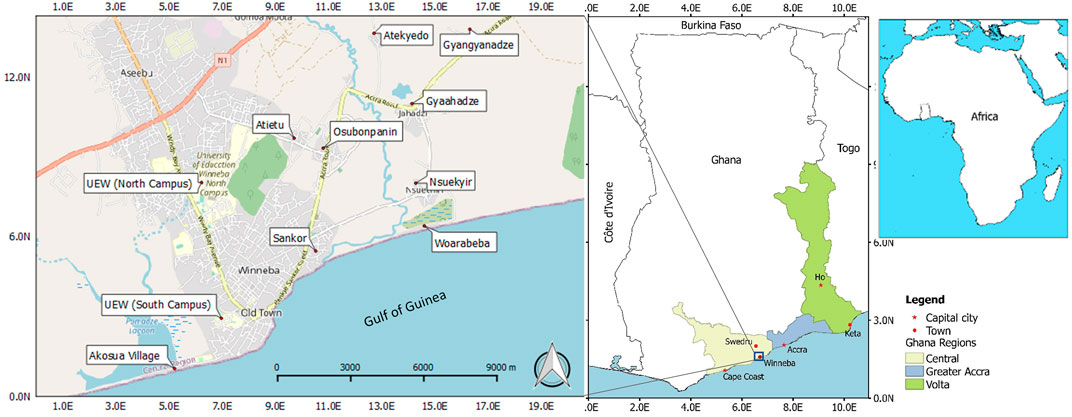
FIGURE 1. Map showing Winneba (Effutu Municipality) and its geopolitical suburbs including Akosua Village and Woarabeba at the coastline.
Livelihood in both communities is based predominantly on beach seine fishing. This is a fishing method that involves the deployment of a large seine net into the sea about 200 m from the shore and manually hauling it to land using ropes. The two study communities are similar in terms of population size, livelihood and social amenities (Table 1). However, they differ into two important ways with respect to fishing operations. AV is a migrant settler community, while WBB is predominantly indigenous. In addition, crew and vessel sizes in WBB are about 2–3 time bigger than those in AV. Moreover, fishing labour arrangements in AV are based on daily wages and thus limited by daily labour availability, while that in WBB is based on year-long contracts secured through the payment of income advances to crew members. This guarantees labour availability and fishing activities throughout the year, weather permitting.
Data Collection and Analysis
A total of 120 households from both communities were selected and surveyed through a stratified-snowball sampling technique. In addition, 8 gender (male/female) and age-group (old/young) disaggregated Focus Group Discussions (FGDs), and several semi-structured interviews and key informant discussion with government officials and community leaders were conducted to identify livelihood stressors, understanding their nature and impacts, and to validate initial findings of the study.
The household surveys and FGDs included a risk mapping activity which was the key tool used to identify stressors and establish the importance and severity indices for stressors The importance index is the ranking of a stressor in the context of all stressors and the severity index is a measure of how severe a stressor is perceived as. The risk mapping draws on a participatory group method used by (Smith et al., 2000; Tschakert, 2007; Nyantakyi-Frimpong & Bezner-Kerr, 2015). In a group setting, each respondent lists the challenges affecting their livelihood, ranks them in descending order of importance then indicates with 0–5 pebbles the severity of each challenge. This group process is rather time-consuming and could easily lead to a groupthink situation. To avoid this, the risk mapping activity was included in the individual household surveys. This approach had two advantages: respondent privacy and individual thought, and the advantage of being able to collect more responses than what can usually be handled in a group activity. Smith et al. (2000) and Tschakert (2007) who were the pioneers of the method recommended that it could be improved by modifications to capture a temporal dimension that would reflect how risk or stressor levels change along some time gradient. To attempt an implementation of this recommendation, which to the best of our knowledge has not been tried before, the last step of the activity (indicating stressor severity with 0–5 pebbles) was repeated: the first for indicating stressor severity in the major fishing season, and the repeated step for indicating stressor severity in the minor fishing season.
The results of the stressor importance and severity ranking were mapped in a bubble plot with three variables: incidence index, importance index, and severity index. These were calculated from the data and plotted with importance index on the y-axis, incidence index on the x-axis, and severity as the size of the bubble (Smith et al., 2000; Tschakert, 2007; Nyantakyi-Frimpong & Bezner-Kerr, 2015). The calculation of each index is as follows:
Incidence index (I) = proportion of respondents mentioning a particular challenge. Ranges from 0–1.
Importance index (P) = ([r − 1)/(n − 1) × (−1) + 1 where r is the rank of a challenge and n is the total number of challenges identified by a respondent and averaged for all respondents mentioning that challenge. Ranges from 0–1. The last variable (+1) at the end of the formula is not in the original. It was added in this study to allow for stressors that had importance indices of less than 1 to still be plotted.
Severity index (S) = mean number of pebbles assigned to each challenge, multiplied by 2 Ranges from 0–10 (0 for inconsequential impact and 10 for most disconcerting impact).
The bubble plots of risk maps were analysed and compared between male and female-headed households. Also, because the severity was assessed for two time periods (major and minor fishing seasons) statistical analyses (Wilcoxon Signed Rank test; α = 0.05) were performed to test if stressor severity differed between fishing seasons, and in which season stressor severity was highest. Interview and FGDs were transcribed and analysed thematically in NVivo qualitative analysis software. The I (incidence index), P (Importance index), and S (Severity index) of climate change-related stressors were highlighted and compared with other stressors for each gender group, in each community. Seasonal variations in stressor severity were also noted.
Results
Experiences of Climatic Stressors
Analysis of all available climatic data for Winneba (1964–2018, 54 years) by Koomson et al. (2020) showed that average daily minimum temperatures have increased by 0.65°C. In addition, the analyses showed that although total annual rainfall had increased over the period, the distinctive major and minor wet season patterns in the last decade had changed with less rainfall being recorded during the wet seasons, and more rainfall being recorded outside. Responses of residents to survey and FGD questions about climatic change revealed that there is a widespread local perception of these changing climatic conditions. This was expressed in terms of perceived changes in weather conditions (e.g., rainfall, temperature, storminess), changes in the physical environment (e.g., coastline and lagoon) associated with SLR and changes in fish catches. The fishing occupation requires predictable and reliable weather conditions because of the risk of exposure to adverse weather conditions at sea. This is particularly so for small-scale or artisanal fishers who use simple fishing equipment with very little or no safety equipment (Afoakwah et al., 2018; Quagrainie and Chu, 2019). Because the major and minor fishing seasons are organised around the major and minor rainy seasons, changes in weather patterns impact fishing and fish processes activities. The exact timing of onset of the major rainy season can delay, lengthen, or sometimes truncate the major fishing season. This interrupts livelihood and household income leading to food and nutritional insecurity amongst other consequences. In addition, unexpected day-to-day changes in weather conditions which are considered unfavourable or risky for fishing expeditions affect household incomes as fishing must be suspended for that day. At worse, unexpected changes in weather conditions while at sea result in fatalities and damages of fishing boats and gears. These conditions have both long and short-term sociocultural and economic impacts on the communities, which have made them constant observers of weather conditions. Through this, they have accumulated rich indigenous knowledge about local weather patterns and can perceive, and even predict, both long- and short-term changes in climatic conditions.
The community respondents noted a perceived reduction in the amount of rainfall, particularly in the major rainy seasons, as well as its unpredictability and this was perceived to affect their fishing activities and be unfavourable for fishing:
“There’s change. It is not like the first time. At times you feel like June will bring heavy rain, but that moment you’ll see that it’s less… Some time ago, during 15th May, the rain used to come with heavy wind. So, early morning if you see that the weather is not all that good, you know it will come with heavy wind. So, if you are going to cast the net you must be careful. But now, it is not so. As we are sitting here, it can rain anytime… the day that you are not expecting rain, it will just rain that day.” (Participant /Older men FGD/AV/Nov/2018).
Another woman in Woarabeba noted:
“Yes, there is a difference. At first the heavy rains used to fall around August before the Akwanbor festival. This year the heavy rains set in after August around, November” (Female household head/HHS/WBB/Dec/2019).
Women from both communities also expressed concern about how erratic the rainfall pattern had become and how it impacts their fish processing (mainly drying) and trade (Figure 2). One woman in Woarabeba complained:
“…the rains have destroyed so much already. It is really detrimental to our line of work. The rains destroy our fish and it poses a lot of financial loss. Someone lost about GHS 1500 (approx. $260.00) worth of dried fish through the rains” (Participant/Female-FGD/AV/Dec/2018).
Another young woman in Akosua Village complained:
“Last year, I invested about GHS 2000 (approx. $340.00) into this business. I bought so much fish to dry and the rain came unexpectedly and destroyed everything” (Young woman/KID/AV/Dec/2018).
While low rainfall experienced recently is seen as partly responsible for low fish catches, high rainfall in the major rainy season was noted as usually being followed by large fish catches. It is unclear what scientific explanation confirms this narrative, although similar narratives have been reported from small fishing communities in Tanzania and Mozambique (Bunce et al., 2010). Low rainfall not only impacts fishing activities at sea but also in the lagoon. This is because low rainfall together with high temperatures reduce the surface area of the lagoon, making it a closed system where salinity could be even higher than the sea, and food availability for lagoon fish very low (Koranteng et al., 2000). In such closed lagoon systems, very few fish species could survive; in most cases, according to Pauly (1976), only one fish species (Sarotherodon melanotheron) is found. According to Davies-Vollum et al. (2018), longer-term impacts of climate change through SLR affect the connection between the lagoon and the sea, which in turn alters the chemical (salinity and water quality) and biological (fish diversity and abundance) characteristics of the lagoon. Flooding was commonly mentioned in Woarabeba. Shortly before data collection in the community a heavy two-days rainfall caused the overflow of the lagoon and flooding event which resulted in the destruction of houses and in some instances, fatalities (Figure 3). According to the Chief of the community, this was an unexpected event in the month of November and nobody in the community was prepared for it. This event is commensurate with evidence of rainfall intensification in Winneba reported by Koomson et al. (2020). In comparison with rainfall, not much was said by respondents in both communities about temperature changes. These lived experiences illustrate how climatic changes have adversely impacted the livelihood and wellbeing of the two communities.
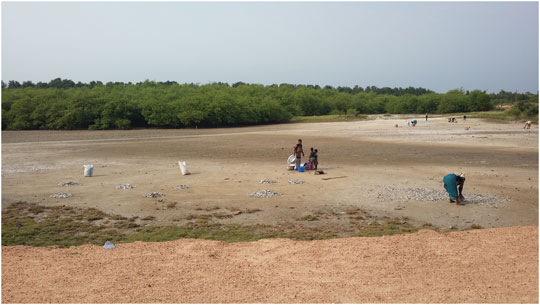
FIGURE 2. Women in Woarabeba community collecting their half-dried fishes from the open lagoon bed due to overcast sky and anticipation of rain.
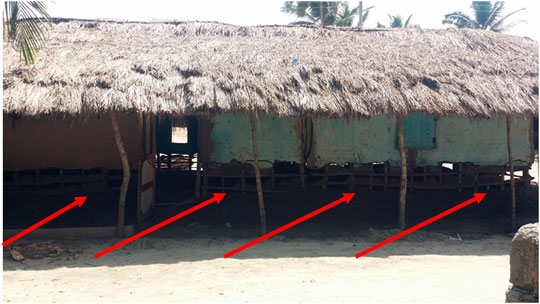
FIGURE 3. A house in Woarabeba destroyed by the recent flooding even in November 2019 (Arrows pointing to base of the building damaged by flood waters).
Experience of Non-Climatic Stressors
Several non-climatic livelihood stressors were noted by residents in the communities. These were thematically divided into infrastructural, sociocultural, occupational, environmental/resource-use, and governance categories (Table 2). Infrastructural stressors included limited pipe-borne water and electricity supply, absence of toilets and health facilities, and bad roads. These have various impacts on the communities (Table 2). Sociocultural stressors included land insecurity and multiple resource-use conflicts) both within the communities and with intruding trawlers, resource management officials and other resource users. Occupational stressors included absence of cold storage facilities, scarcity of pre-mix fuel required to power fishing boats, illegal fishing activities, absence of alternative livelihoods, and implementation of a closed-season policy. Other more internal stressors included exploitative net owners, a declining workforce, expensive loans and no capital for fish trading (especially for fishmongers). Environmental/resource-use stressors included poor waste disposal within and outside the communities and restricted access to the lagoons (especially the Muni lagoon near Akosua Village due to its Ramsar status) for fishing and mangrove harvesting. Lastly, governance stressors included political discrimination in the allocation of development funds (particularly for the migrant community) and lack of government support in times of disaster. Specific impacts of these stressors are summarised in Table 2 Together, these non-climatic stressors create a contextual condition within which adaptive capacity and resilience to climatic stressors are decreased or cannot be effectively mobilised.
Relative Importance and Severity of Climatic and Non-Climatic Stressors
Figures 4–7 display the results of the participatory risk mapping exercise for female (FHH) and male (MHH) headed households in each community. In Akosua Village, FHHs identified only one climate change-related stressor (fewer fish catches), which was also the stressor with the highest incidence and importance (I ≥ 0.5; p ≥ 0.5). This indicates a high relative importance of climate-induced threats on women’s livelihood. However, although fewer fish catches showed high incidence and importance, it was not the most severely felt stressor. The most severely felt stressors were lack of capital, electricity, and the poor condition of roads (Figure 4A). In the minor fishing season when fishing activities are limited and not much fish trading goes on, the stressors that directly affect fish trading (no capital, bad road, and fewer fish catches) are significantly reduced (Figure 4B). The severity of the other stressors (no water, electricity, toilets) which may be categorised as basic amenities, remains unchanged. In Woarabeba also, fewer fish catches showed the highest incidence and importance (Figure 6A). Flooding and erratic rainfall were also mentioned as climate change-related stressors but were ranked lower in importance to fishing with lights (an illegal and destructive fishing method), lack of jobs, and mangrove prohibition (Figure 6A). Similar to FHHs in Akosua Village, climate change-related stressors were not the most severely felt stressors. The most severely felt stressors were lack of capital, jobs, and competition from too many nets (or fishing vessels). In the minor fishing season, however (Figure 6B), the change in severity perception is different from that of Akosua Village. While the severity of fewer fish catches reduces in Akosua Village, it increased three-fold in Woarabeba (Figure 6B). In addition, unlike Akosua Village, lack of capital retains high severity in the minor season. This could be explained by the fact that there is secured fishing labour throughout the year in Woarabeba which sustains a relatively greater level of fishing activity in the minor season than in Akosua Village, and thus, sustained fish trading. In fact, following the economic principles of demand and supply, fish prices are relatively higher in the minor seasons (Nunoo et al., 2015; Onumah et al., 2020), and being able to trade during that period increases chances of profitability. Lastly, the concern about the closed fishing season policy appears in the high incidence, low importance quadrat for Woarabeba FHHs, but not for Akosua Village. This can be attributed to the fact that the closed fishing season policy was first implemented in the minor season (May-June) of 2019 after data collection had ended in Akosua Village but before data collection in Woarabeba later that year. The closed fishing season policy is likely to be of concern in Akosua Village going forward.
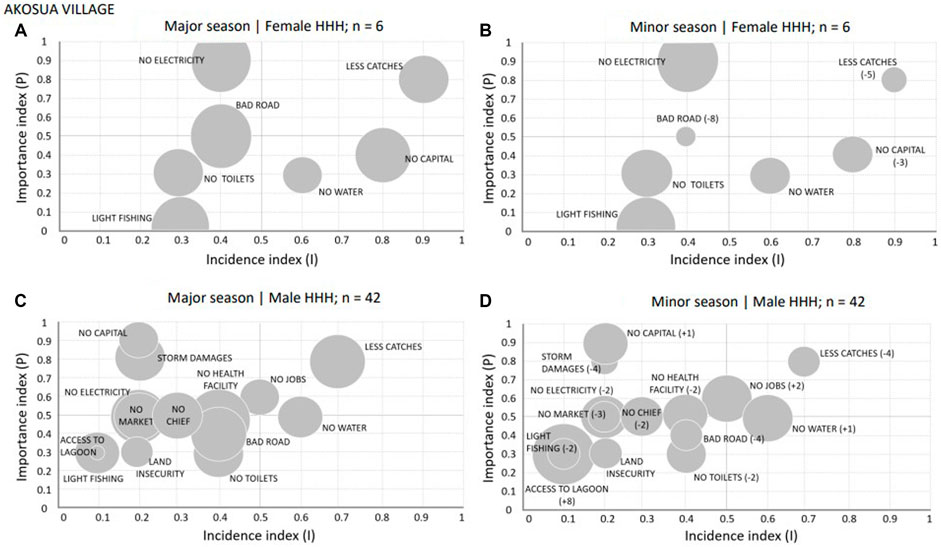
FIGURE 4. Composite participatory risk maps for females (A,B) and males (C,D) in Akosua Village during major (A,C) and minor (B,D) fishing seasons.

FIGURE 5. Composite participatory risk maps for Akosua Village for major (A) and minor (B) fishing seasons (Data for male and female-headed households combined).
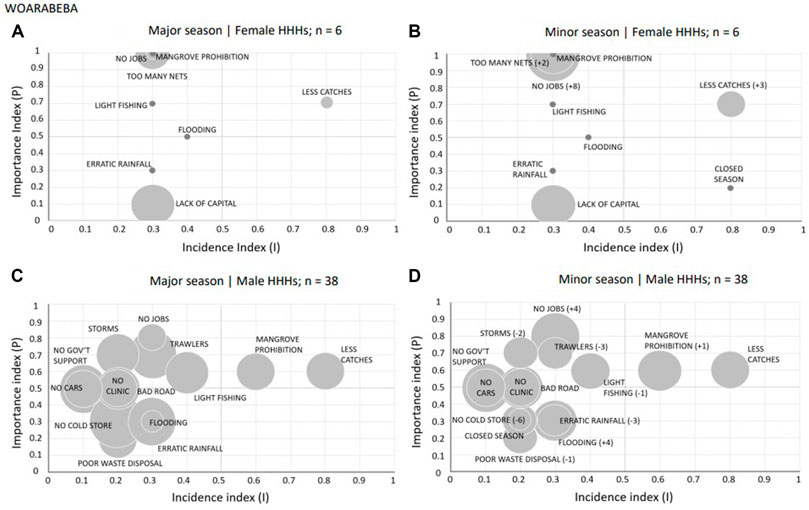
FIGURE 6. Composite participatory risk maps for females (A,B) and males (C,D) in Woarabeba during major (A,C) and minor (B,D) fishing seasons.
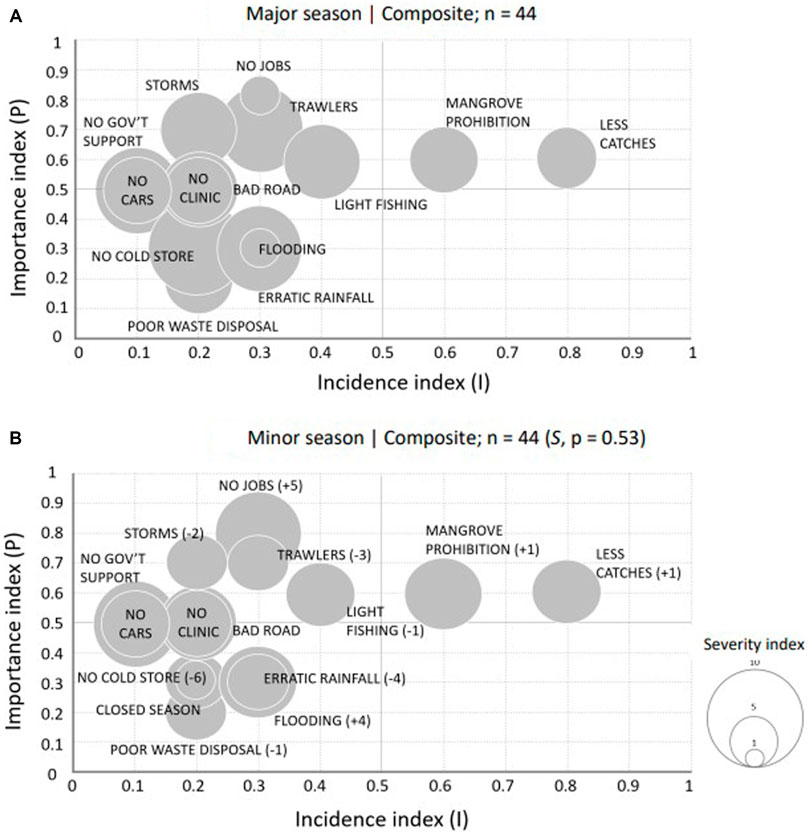
FIGURE 7. Composite participatory risk maps for Woarabeba for major (A) and minor (B) fishing seasons (Data for male and female-headed households combined).
MHHs in Akosua Village identified more stressors than FHHs (Figure 4C). However, similar to FHHs, fewer fish catches showed the highest incidence and importance (I ≥ 0.5; p ≥ 0.5) for MHHs (Figure 4C). Storm damages were also mentioned as a climate change-related stressor, and together with less fish catches, were ranked very highly on the importance scale in the major fishing season (Figure 4C). Large differences in severity could be seen in the minor season. Figure 4D shows that the perceived severity of all the stressors, both climatic and non-climatic, with the exception of no capital and jobs, are reduced. As expected, the need for alternative jobs increases due to the dip in fishing activities and incomes in the minor season. Notably, comparing Figures 4C,D, shows that the need for access to the Ramsar protected Muni lagoon is significantly increased in the minor season, highlighting the need for alternative sources of income in the minor fishing seasons. MHHs in Woarabeba identified more climate change-related stressors than any other group—fewer catches, erratic rainfall, flooding, and storms. This could be attributed to the fact that a major flooding incident had taken place few weeks prior to data collection in the community. Consequently, access to mangroves for reconstructing homes post-flooding, together with fewer catches are in the high incidence, high importance quadrat (I ≥ 0.5; p ≥ 0.5; Figures 6C,D). Lagoon access in Akosua Village is most needed for fishing, while in Woarabeba it is for sourcing mangroves for poles and firewood. Another key difference between the two villages is that, while the severity of fewer catches reduces in the minor season for MHHs in Akosua Village, it is unchanged for MHHs in Woarabeba. On the composite risk maps also, the risk of fewer fish catches reduces in the minor season (−4) for Akosua Village while it increases slightly (+1) in Woarabeba (Figures 5B, 7B). Another striking observation is the need for jobs in the minor seasons. Similar to FHHs in Woarabeba, the need for jobs is the stressor with the highest increment in severity for MHHs (Figures 6C,D). It is clear from the composite risk maps that in both communities, the need for alternative jobs is in the high importance quadrat and of the highest (Woarabeba) or second highest (Akosua Village) severity during the minor fishing season (Figures 5B, 7B).
Discussion
The findings contribute to the wider discussion on the need to understand where climate change fits in the mix of stressors that shape the vulnerability of rural natural resource-dependent communities and livelihoods (Smith et al., 2000; Tschakert, 2007; Nyantakyi-Frimpong and Bezner-Kerr, 2015; MucCubbin et al., 2015; Malakar et al., 2018; Freduah et al., 2019). Previous studies from agrarian communities (Tschakert, 2007; Nyantakyi-Frimpong and Bezner-Kerr, 2015), from Small Island Developing States (SIDs) communities (MucCubbin et al., 2015), and from urban fishing communities (Malakar et al., 2018) have all pointed to the notion that climate change-related stressors are of relatively less importance to natural resource-dependent communities in the face of multiple socio-economic stressors. However, the findings of this study suggest that climate change and its impacts (fewer catches and storms) are of high importance to fishing communities because of their direct impacts on their only source of income. The increasingly erratic start to and nature of the rainy seasons and the shift in timing of the heaviest rains have caused loss of fishing time and equipment as well as impeding the fish drying process. Bunce et al. (2010) in a study of rural fishing communities in Tanzania and Mozambique reached a similar conclusion as climate change/variability was ranked very highly in the fishing communities they studied. This highlights the crucial importance of context, as argued by Bradsley and Wiseman (2012), in differentiating peoples’ lived experiences of climate impacts and hence, their perception of the importance of climatic stressors. This is demonstrated furthermore by the fact that, although the two study communities have several similarities, place-based differences have resulted in contrasting (Table 1) perceived severity of stressors between the major and the minor fishing seasons. The findings also show that climate change impacts are not necessarily the most severely felt stressors in the fishing communities, especially in the minor fishing seasons. This agrees with the previous studies from agrarian contexts (Tschakert, 2007; Nyantakyi-Frimpong and Bezner-Kerr, 2015).
If asking two different questions about importance and severity for the same stressor results in an inverse perspective about that stressor, then consideration of whether these questions are appropriate is valuable. Consideration of the methodology of this and similar studies (Tschakert, 2007; Bunce et al., 2010; Nyantakyi-Frimpong and Bezner-Kerr, 2015) reveals that interviewee’s responses to importance ranking were subconsciously determined by their sense of the direct impacts of stressors on their livelihood and incomes, while responses to severity ranking were subconsciously determined by a consideration of their lives in general. Thus, for example, in Tschakert (2007) and Nyantakyi-Frimpong and Bezner-Kerr (2015), where farming communities were studied, climate change was ranked low in importance and severity, because low/erratic rainfall and yields could be mitigated to some extent by irrigation and soil fertilization or use of improved crop varieties. Thus, the perceived impact of seed failure, land security and other non-climatic stressors were ranked above climate change-related impacts in both importance and severity. However, in the rural fishing communities of this study and those described in Bunce et al. (2010) climate change is ranked highly in importance. In these communities, climate change leads to low fish catches, lost income due to lost fishing days and/or equipment due to storminess, or lost income due to erratic rains destroying drying fishes—all key aspects of the fishing livelihood. However, in terms of severity (connected to lives in general), other non-climatic stressors are ranked above climate change-related ones. Therefore, in response to the increasing calls to appropriately contextualise climate impact studies, and as far as the ranking methods for studying multiple natural resource dependent livelihood stressors are concerned, it is essential to move away from focusing on relative importance alone, to the inclusion of relative severity for a more contextualised and nuanced understanding of multiple stressors.
The insights gained from this study can be used to improve resource governance and in decision making when planning for climate change adaptation in coastal communities. Fishing communities perceive climate change-related stressors to be of high relative importance. This understanding is significant for supporting political arguments at the national or even international levels on the need for climate change mitigation for SSFs, and to lobby for budgetary allocations for adaption initiatives in fishing communities. Knowledge of the perceived relative severity of multiple stressors could be used to prioritise locations and interventions for equitable and socially just adaptation action. That is, interventions to reduce the severity and/or improve adaptation to specific stressors could be prioritised for communities or sub-community sections that have highest severity index.
This study’s finding that the severities of social and infrastructural needs are likely to increase with livelihood development is instrumental to adaptation planning. To improve the economic profitability of a livelihood, or to provide a more economically viable option, for example aquaculture, may improve only the financial assets of people. It may not improve the social, natural and human assets needed for a holistic enhancement of adaptive capability and resilience. Profitable or economically viable livelihoods must not be confused with sustainable livelihoods. Indeed, better incomes could increase financial assets which would offer households more asset convertibility options (Badjeck et al., 2010). However, it has been shown that households do not necessarily convert their financial assets into other capital assets in order to improve their adaptive capacity (Adger et al., 2007; Bunce et al., 2010). Besides, that there are multiple factors at several scales that can undo any financial gains made or become barriers to their conversion to other livelihood assets (Adger et al., 2007; Moser and Ekstrom, 2010; Charlse, 2012; Islam et al., 2014b). Knowledge of the relative severity of stressors serves as a useful guide in directing adaption funds into actions that would create short term impacts by relieving fishing communities of the stressors that impinge most severely on their lives. At the same time, it can provide the enabling socio-economic context within which fishing livelihood (or any other livelihood) can thrive. Relative importance insights, as used in this study, support political justification for securing adaptation funds while relative severity insights can be employed to prioritise socio-economic issues within local communities. The findings therefore make practical contributions to calls to use climate change as a platform to address wider societal problems (Smith and Wandel, 2006; Gaillard, 2012; MuCubbin et al., 2015; Freduah et al., 2019), and to link adaptation with development (Bunce et al., 2010; Moore, 2010; Davies-Vollum et al., 2021). This would ultimately mitigate vulnerability because vulnerability is shaped not only by exposure to climatic stressors alone but also, and perhaps more importantly, by social and economic processes (Adger, 1999; O’Brien et al., 2007; Kates et al., 2012; Thomas et al., 2019).
Conclusion
The study investigates the relative importance and severity of climate change in the context of multiple socioeconomic stressors in rural small-scale fishing communities in Ghana. The findings suggest that climate change-related stressors are of high importance to the fishing communities due to the direct impacts they have on their fishing livelihood and incomes. However, socioeconomic stressors are more severely felt than climate change-related stressors. It is argued that this approach and the insights provided by it can provide input to the lobby for national budgetary allocation and strategy for climate change adaptation. The approach can support decision-making relating to both locations and actions during the adaptation planning process to maximise outcomes that create more secure futures for coastal fishing communities in the Global South.
Data Availability Statement
The original contributions presented in the study are included in the article/supplementary material, further inquiries can be directed to the corresponding author.
Author Contributions
The author confirms being the sole contributor of this work and has approved it for publication.
Funding
This work is part of a PhD study funded by the Environmental Sustainability Research Centre (ESRC) at the University of Derby, United Kingdom.
Conflict of Interest
The authors declare that the research was conducted in the absence of any commercial or financial relationships that could be construed as a potential conflict of interest.
Publisher’s Note
All claims expressed in this article are solely those of the authors and do not necessarily represent those of their affiliated organizations, or those of the publisher, the editors and the reviewers. Any product that may be evaluated in this article, or claim that may be made by its manufacturer, is not guaranteed or endorsed by the publisher.
Acknowledgments
We appreciate the support of Chiefs, elders, opinion leaders and members of the two communities who took part in the study. We also acknowledge the assistance of former manager of Muni-Pumadze Ramsar site, Andrew Agyekumhene for facilitating entry into the study communities. We also appreciate the editor and reviewers of this paper for their helpful comments and review.
References
Adger, W. N., Agrawala, S., Mirza, M. M. Q., CondeO’Brien, C. K., Pulhin, J., Pulwarty, R., et al. (2007). “Assessment of Adaptation Practices, Options, Constraints and Capacity,” in Climate Change 2007: Impacts, Adaptation and Vulnerability. Contribution of Working Group II to the Fourth Assessment Report of the Intergovernmental Panel on Climate Change. Editors M. L. Parry, O. F. Canziani, J. P. Palutikof, P. J. van der Linden, and C. E. Hanson (Cambridge, UK: Cambridge University Press), 717–743.
Afoakwah, R., Osei, M. B. D., and Effah, E. (2018). “A Guide on Illegal Fishing Activities in Ghana,” in USAID/Ghana Sustainable Fisheries Management Project (Narragansett, RI: Coastal Resources Center, Graduate School of Oceanography, University of Rhode Island. Prepared by the University of Cape Coast, Ghana. GH2014_SCI048_UCC), 64.
Ashley, C., and Carney, D. (1999). Sustainable Livelihoods: Lessons from Early Experience. Dep. Int. Dev. 7.
Badjeck, M.-C., Allison, E. H., Halls, A. S., and Dulvy, N. K. (2010). Impacts of Climate Variability and Change on Fishery-Based Livelihoods. Mar. Policy 34 (3), 375–383. doi:10.1016/j.marpol.2009.08.007
Bardsley, D. K., and Wiseman, N. D. (2012). Climate Change Vulnerability and Social Development for Remote Indigenous Communities of South Australia. Glob. Environ. Change 22 (3), 713–723. doi:10.1016/j.gloenvcha.2012.04.003
Belhabib, D., Lam, V. W. Y., and Cheung, W. W. L. (2016). Overview of West African Fisheries under Climate Change: Impacts, Vulnerabilities and Adaptive Responses of the Artisanal and Industrial Sectors. Mar. Policy 71, 15–28. doi:10.1016/j.marpol.2016.05.009
Béné, C. (2006). Small-Scale Fisheries_Assessing Their Contribution to Rural Livelihoods in Developing Countries. FAO Fish. Circ. No. 1008 Rome 1008. Rome: FAO, 46p.
Boateng, I. (2012). An Application of GIS and Coastal Geomorphology for Large Scale Assessment of Coastal Erosion and Management: a Case Study of Ghana. J. Coast Conserv. 16, 383–397. doi:10.1007/s11852-012-0209-0
Bunce, M., Rosendo, S., and Brown, K. (2010). Perceptions of Climate Change, Multiple Stressors and Livelihoods on Marginal African Coasts. Environ. Dev. Sustain 12 (3), 407–440. doi:10.1007/s10668-009-9203-6
Carney, D. (1998). Sustainable Rural Livelihoods: What Contribution Can We Make? London: DFID, 213213.
Chambers, R., and Conway, G. R. (1992). Sustainable Rural Livelihoods: Practical Concepts for the 21st Century. Brighton: IDS Discussion Paper, 296.
Charles, A. (2012). People, Oceans and Scale: Governance, Livelihoods and Climate Change Adaptation in Marine Social-Ecological Systems. Curr. Opin. Environ. Sustain. 4 (3), 351–357. doi:10.1016/j.cosust.2012.05.011
Cheung, W. W. L., Lam, V. W. Y., Sarmiento, J. L., Kearney, K., Watson, R., Zeller, D., et al. (2010). Large-scale Redistribution of Maximum Fisheries Catch Potential in the Global Ocean under Climate Change. Glob. Change Biol. 16 (1), 24–35. doi:10.1111/j.1365-2486.2009.01995.x
Davies-Vollum, K. S., Raha, D., and Koomson, D. (2021). “Climate Change Impact and Adaptation: Lagoonal Fishing Communities in West Africa,” in African Handbook of Climate Change Adaptation (Cham: Springer), 2221–2245. doi:10.1007/978-3-030-45106-6_221
Davies-Vollum, K. S., Zhang, Z., and Agyekumhene, A. (2018). Impacts of Lagoon Opening and Implications for Coastal Management: Case Study from Muni-Pomadze Lagoon, Ghana. J. Coast Conserv. 23 (2), 293–301. doi:10.1007/s11852-018-0658-1
FAO (2018). The State of World Fisheries and Aquaculture 2018 - Meeting the Sustainable Development Goals. Rome.
FAO (2015). “Voluntary Guidelines for Securing Sustainable Small-Scale Fisheries,” in Voluntary Guidelines for Securing Sustainable Small-Scale Fisheries in the Context of Food Security and Poverty Eradication. Retrieved from http://www.fao.org/docrep/field/003/ab825f/AB825F00.htm#TOC.
Freduah, G., Fidelman, P., and Smith, T. F. (2019). Adaptive Capacity of Small‐scale Coastal Fishers to Climate and Non‐climate Stressors in the Western Region of Ghana. Geogr. J. 185 (1), 96–110. doi:10.1111/geoj.12282
Gaillard, J. C. (2012). The Climate Gap. Clim. Dev. 4 (4), 261–264. doi:10.1080/17565529.2012.742846
Gordon, C. (2000). Hypersaline Lagoons as Conservation Habitats: Macroinvertebrates at Muni Lagoon, Ghana. Biodivers. Conserv. 9, 465–478. doi:10.1023/a:1008906503227
Islam, M. M., Sallu, S., Hubacek, K., and Paavola, J. (2014a). Vulnerability of Fishery-Based Livelihoods to the Impacts of Climate Variability and Change: Insights from Coastal Bangladesh. Reg. Environ. Change 14 (1), 281–294. doi:10.1007/s10113-013-0487-6
Jacob, S., Farmer, F. L., Jepson, M., and Adams, C. (2001). Landing a Definition of Fishing Dependent Communities: Potential Social Science Contributions to Meeting National Standard 8. Fisheries 26 (10), 16–22. doi:10.1577/1548-8446(2001)026<0016:ladofd>2.0.co;2
Kates, R. W., Travis, W. R., and Wilbanks, T. J. (2012). Transformational Adaptation when Incremental Adaptations to Climate Change Are Insufficient. Proc. Natl. Acad. Sci. U.S.A. 109 (19), 7156–7161. doi:10.1073/pnas.1115521109
Koomson, D., Davies-Vollum, K. S., and Raha, D. (2020). Characterising the Vulnerability of Fishing Households to Climate and Environmental Change: Insights from Ghana. Mar. Policy 120, 104142. doi:10.1016/j.marpol.2020.104142
Koranteng, K. A., Ofori-Danson, P. K., and Entsua-Mensah, M. (2000). Fish and Fisheries of the Muni Lagoon in Ghana, West Africa. Biodivers. Conservation 9 (4), 487–499. doi:10.1023/a:1008903813222
Lam, V., Cheung, W., Swartz, W., and Sumaila, U. (2012). Climate Change Impacts on Fisheries in West Africa: Implications for Economic, Food and Nutritional Security. Afr. J. Mar. Sci. 34 (1), 103–117. doi:10.2989/1814232x.2012.673294
Malakar, K., Mishra, T., and Patwardhan, A. (2018). Perceptions of Multi-Stresses Impacting Livelihoods of Marine Fishermen. Mar. Policy 97 (105), 18–26. doi:10.1016/j.marpol.2018.08.029
McCubbin, S., Smit, B., and Pearce, T. (2015). Where Does Climate Fit? Vulnerability to Climate Change in the Context of Multiple Stressors in Funafuti, Tuvalu. Glob. Environ. Change 30, 43–55. doi:10.1016/j.gloenvcha.2014.10.007
Mensah, K. O., and Fitzgibbon, J. (2013). Responsiveness of Ada Sea Defence Project to Salt Water Intrusion Associated with Sea Level Rise. J. Coast Conserv. 17, 75–84. doi:10.1007/s11852-012-0219-y
Monirul Islam, M., Sallu, S., Hubacek, K., and Paavola, J. (2014b). Limits and Barriers to Adaptation to Climate Variability and Change in Bangladeshi Coastal Fishing Communities. Mar. Policy 43, 208–216. doi:10.1016/j.marpol.2013.06.007
Moore, F. C. (2010). Doing Adaptation” the Construction of Adaptive Capacity and its Function in the International Climate Negotiations. St. Ant. Int. Rev. 5 (2), 66–88.
Moser, S. C., and Ekstrom, J. A. (2010). A Framework to Diagnose Barriers to Climate Change Adaptation. Proc. Natl. Acad. Sci. U.S.A. 107 (51), 22026–22031. doi:10.1073/pnas.1007887107
Neil Adger, W. (1999). Social Vulnerability to Climate Change and Extremes in Coastal Vietnam. World Dev. 27 (2), 249–269. doi:10.1016/s0305-750x(98)00136-3
Nunoo, F. K. E., Asiedu, B., Kombat, E. O., and Samey, B. (2015). Sardinella and Other Small Pelagic Value and Supply Chainof the Fishery Scetor, Ghana. The USAID/Ghana Sustainable Fisheries Management Project (SFMP). Narragansett, RI: Coastal Resources Center, Graduate School of Oceanography, University of Rhode Island and Netherlands Development Organisation. GH2014_ACT044_SNV.
Nyantakyi-Frimpong, H., and Bezner-Kerr, R. (2015). The Relative Importance of Climate Change in the Context of Multiple Stressors in Semi-arid Ghana. Glob. Environ. Change 32, 40–56. doi:10.1016/j.gloenvcha.2015.03.003
O'Brien, K., Eriksen, S., Nygaard, L. P., and Schjolden, A. (2007). Why Different Interpretations of Vulnerability Matter in Climate Change Discourses. Clim. policy 7 (1), 73–88. doi:10.1080/14693062.2007.9685639
O’Brien, K., Leichenko, R., Kelkar, U., Venema, H., Aandahl, G., Tompkins, H., and West, J. (2004). Mapping Vulnerability to Multiple Stressors: Climate Change and Globalization in India. Glob. Environ. change 14 (4), 303–313.
Onumah, E. E., Quaye, E. A., Ahwireng, A. K., and Campion, B. B. (2020). Fish Consumption Behaviour and Perception of Food Security of Low-Income Households in Urban Areas of Ghana. Sustainability 12 (19), 7932. doi:10.3390/su12197932
Pauly, D. (1976). The Biology, Fishery and Potential for Aquaculture of Tilapia Melanotheron in a Small West African Lagoon. Aquaculture 7 (1), 33–49. doi:10.1016/0044-8486(76)90030-2
Quagrainie, K. K., and Chu, J. (2019). Determinants of Catch Sales in Ghanaian Artisanal Fisheries. Sustainability 11 (2), 298. doi:10.3390/su11020298
Sagoe-Addy, K., and Appeaning Addo, K. (2013). Effect of Predicted Sea Level Rise on Tourism Facilities along Ghana's Accra Coast. J. Coast Conserv. 17, 155–166. doi:10.1007/s11852-012-0227-y
Scoones, I. (1998). Sustainable Rural Livelihoods: A Framework for Analysis, IDS Working Paper 72. IDS Work. Pap. 72 (May), 1–22.
Smit, B., and Wandel, J. (2006). Adaptation, Adaptive Capacity and Vulnerability. Glob. Environ. change 16 (3), 282–292. doi:10.1016/j.gloenvcha.2006.03.008
Smith, K., Barrett, C. B., and Box, P. W. (2000). Participatory Risk Mapping for Targeting Research and Assistance: with an Example from East African Pastoralists. World Dev. 28 (11), 1945–1959. doi:10.1016/s0305-750x(00)00053-x
Sumaila, U. R., Cheung, W. W. L., Lam, V. W. Y., Pauly, D., and Herrick, S. (2011). Climate Change Impacts on the Biophysics and Economics of World Fisheries. Nat. Clim. Change 1 (9), 449–456. doi:10.1038/nclimate1301
Thomas, K., Hardy, R. D., Lazrus, H., Mendez, M., Orlove, B., Rivera-Collazo, I., Roberts, J. T., Rockman, M., Warner, B. P., and Winthrop, R. (2019). Explaining Differential Vulnerability to Climate Change: A Social Science Review. Wiley Interdiscip. Rev. Clim. Change 10 (2), e565. doi:10.1002/wcc.565
Tilley, A., Herrón, P., Espinosa, S., Angarita, J. L., and Box, S. (2018). Predicting Vulnerability to Management Changes in Data-Limited, Small-Scale Fisheries. Mar. Policy 94 (May), 39–45. doi:10.1016/j.marpol.2018.04.013
Wellens-Mensah, J., Armah, A. K., Amlalo, D. S., and Tetteh, K. (2002). “Development and Protection of the Coastal and Marine Environment in Sub-saharan Africa: Ghana,” in National Report Phase 1: Integrated Problem Analysis (Nairobi: UNEP).
Keywords: climate change, fishing, rural, coastal, Ghana, stressors
Citation: Koomson D, Davies-Vollum KS and Raha D (2022) Climatic Hazards: High Importance but Low Severity to Coastal Rural Fishing Communities. Earth Sci. Syst. Soc. 2:10052. doi: 10.3389/esss.2022.10052
Received: 10 December 2021; Accepted: 28 April 2022;
Published: 01 July 2022.
Edited by:
Rachel Brackenridge, University of Aberdeen, United KingdomReviewed by:
Jonathan Bridge, Sheffield Hallam University, United KingdomAmanda Daria Stoltz, University of California, Santa Cruz, United States
Copyright © 2022 Koomson, Davies-Vollum and Raha. This is an open-access article distributed under the terms of the Creative Commons Attribution License (CC BY). The use, distribution or reproduction in other forums is permitted, provided the original author(s) and the copyright owner(s) are credited and that the original publication in this journal is cited, in accordance with accepted academic practice. No use, distribution or reproduction is permitted which does not comply with these terms.
*Correspondence: Katherine Sian Davies-Vollum, s.davies-vollum@derby.ac.uk
 Daniel Koomson
Daniel Koomson Katherine Sian Davies-Vollum
Katherine Sian Davies-Vollum